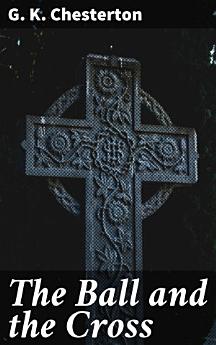The Ball and the Cross
2019 നവം · Good Press
ഇ-ബുക്ക്
258
പേജുകൾ
family_home
യോഗ്യതയുണ്ട്
info
reportറേറ്റിംഗുകളും റിവ്യൂകളും പരിശോധിച്ചുറപ്പിച്ചതല്ല കൂടുതലറിയുക
ഈ ഇ-ബുക്കിനെക്കുറിച്ച്
In G.K. Chesterton's literary masterpiece, 'The Ball and the Cross', the reader is taken on a philosophical and theological journey exploring the clash between reason and faith, personified by two passionate protagonists. This satirical novel delves into the complexities of belief, morality, and the role of religion in modern society, all intertwined with Chesterton's signature wit and humor. Set against the backdrop of late 19th-century England, the book addresses timeless themes that are relevant even in today's world of skepticism and uncertainty. Chesterton's eloquent prose and clever storytelling make this book a captivating and thought-provoking read for any lover of classic literature. As a prolific writer, thinker, and prominent Christian apologist, G.K. Chesterton's unique perspective and deep insights into human nature are evident in 'The Ball and the Cross'. His profound understanding of the interplay between reason and faith, as well as his keen observations of society, influenced his creation of this remarkable work. Chesterton's own devout Catholic beliefs undoubtedly shaped the philosophical underpinnings of the novel, adding layers of depth and complexity to the narrative. I highly recommend 'The Ball and the Cross' to readers interested in exploring the enduring questions of existence, morality, and the nature of belief. Chesterton's brilliant storytelling and deep philosophical musings make this book a must-read for anyone seeking a thought-provoking and intellectually stimulating literary experience.
രചയിതാവിനെ കുറിച്ച്
Gilbert Keith Chesterton was born in London, England, in 1874. He began his education at St Paul's School, and later went on to study art at the Slade School, and literature at University College in London. Chesterton wrote a great deal of poetry, as well as works of social and literary criticism. Among his most notable books are The Man Who Was Thursday, a metaphysical thriller, and The Everlasting Man, a history of humankind's spiritual progress. After Chesterton converted to Catholicism in 1922, he wrote mainly on religious topics. Chesterton is most known for creating the famous priest-detective character Father Brown, who first appeared in "The Innocence of Father Brown." Chesterton died in 1936 at the age of 62.
ഈ ഇ-ബുക്ക് റേറ്റ് ചെയ്യുക
നിങ്ങളുടെ അഭിപ്രായം ഞങ്ങളെ അറിയിക്കുക.
വായനാ വിവരങ്ങൾ
സ്മാർട്ട്ഫോണുകളും ടാബ്ലെറ്റുകളും
Android, iPad/iPhone എന്നിവയ്ക്കായി Google Play ബുക്സ് ആപ്പ് ഇൻസ്റ്റാൾ ചെയ്യുക. ഇത് നിങ്ങളുടെ അക്കൗണ്ടുമായി സ്വയമേവ സമന്വയിപ്പിക്കപ്പെടുകയും, എവിടെ ആയിരുന്നാലും ഓൺലൈനിൽ അല്ലെങ്കിൽ ഓഫ്ലൈനിൽ വായിക്കാൻ നിങ്ങളെ അനുവദിക്കുകയും ചെയ്യുന്നു.
ലാപ്ടോപ്പുകളും കമ്പ്യൂട്ടറുകളും
Google Play-യിൽ നിന്ന് വാങ്ങിയിട്ടുള്ള ഓഡിയോ ബുക്കുകൾ കമ്പ്യൂട്ടറിന്റെ വെബ് ബ്രൗസർ ഉപയോഗിച്ചുകൊണ്ട് വായിക്കാവുന്നതാണ്.
ഇ-റീഡറുകളും മറ്റ് ഉപകരണങ്ങളും
Kobo ഇ-റീഡറുകൾ പോലുള്ള ഇ-ഇങ്ക് ഉപകരണങ്ങളിൽ വായിക്കാൻ ഒരു ഫയൽ ഡൗൺലോഡ് ചെയ്ത് അത് നിങ്ങളുടെ ഉപകരണത്തിലേക്ക് കൈമാറേണ്ടതുണ്ട്. പിന്തുണയുള്ള ഇ-റീഡറുകളിലേക്ക് ഫയലുകൾ കൈമാറാൻ, സഹായ കേന്ദ്രത്തിലുള്ള വിശദമായ നിർദ്ദേശങ്ങൾ ഫോളോ ചെയ്യുക.








